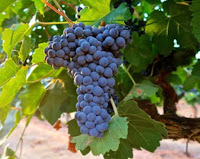One of my wine news feeds had a link to this article:
1929 book on black grapes sheds fascinating light on the history of California wine from Lodi Wine California which I followed up on. The book was written by Joseph Perelli-Minetti for USDA's State of California Department of Agriculture and published in 1929.
1
It is interesting to note that at the time that this book was written, the United States was in the midst of a nationwide Prohibition which lasted from 1920 to 1933.
Joseph Perelli-Minetti wrote that in 1929, there were 38 different black skinned varieties of grapes being cultivated in California.
This 80 page book provided highly detailed photographs and notes on leaf and cluster morphologies of those varieties. Some of which are the following varieties:
| Description |
1929 Photo |
Current Photo |
| Mission Grape |
|
|
The Mission grape was the only European grape cultivated in California prior to statehood in 1850. The grape was planted along El Camino Real by Franciscan missionaries between 1769 and 1833. It is now recognized as the European grape known as Criolla or Pais. The white pulp of the Mission grape was also used to make a wine called Angelica.
Alicante Bouschet, a teinturier (a red skinned variety with red pulp) was a cultivar highly favored during Prohibition for its sturdiness, so it became used for cross-country shipping.
Charbono has now been correctly identified as Bonarda (Argentina), and is synonymous with Douce noir (from France's Savoy region). However, it is still grown and bottled in California as Charbono.
Almost all of the grapes grown in California and identified as Gamay is now correctly identified as Valdiguié originating in France's Languedoc-Roussillon region. It was not until 1980 that UC Davis provided the correct identification of California Gamay. Up until that time, there was also a variety bottled as Gamay Beaujolais, which turned out to be neither a true Gamay nor Valdiguié, but rather a clonal variant of Pinot noir.
Cultivated in California as Mataró, in the 1980's during the rise of the Rhone Rangers, it was understood that Mataró, Mourvèdre and Monastrell all referred to the same grape.
| Petite Sirah - identified as the French Durif |
|
|
|
As recently as the mid-1990s, Petite Sirah was mistakenly believed to be a clonal variant of Syrah. In 1997 UC Davis established, once and for all, that almost all the Petite Sirah grown in California is identical to the variety known in France as Durif. It is a cross made in the 1860s of Peloursin and Syrah grapes and attributed to a Montpellier, France botanist named François Durif.
References:
1. Randy Caparoso,
1929 book on black grapes sheds fascinating light on the history of California wine, Lodi Wine California, Letters from Lodi, January 9, 2024.













No comments:
Post a Comment